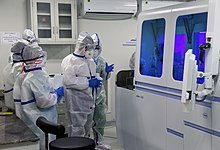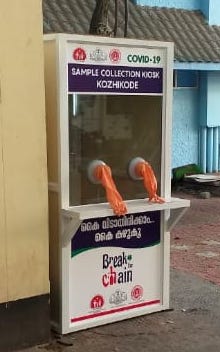COVID-19 & RBI
On 30 January, India reported its first case of COVID-19 in Kerala, which rose to three cases by 3 February; all were students returning from Wuhan. Apart from these, no significant rise in transmissions was observed in February. On 4 March 22 new cases were reported, including 14 infected members of an Italian tourist group.[36][37]
In March, the transmissions grew after several people with travel history to affected countries, and their contacts, tested positive. On 12 March, a 76-year-old man, with a travel history to Saudi Arabia, became the first COVID-19 fatality of India.[38]
A Sikh preacher, who had a travel history to Italy and Germany, turned into a "super spreader" by attending a Sikh festival in Anandpur Sahib during 10–12 March.[39][40] Twenty-seven COVID-19 cases were traced back to him.[41] Over 40,000 people in 20 villages in Punjab were quarantined on 27 March to contain the spread.[40][42]
On 31 March, a Tablighi Jamaat religious congregation event in Delhi, which had taken place earlier in March, emerged as a new virus super spreader event, after numerous cases across the country were traced back to it. On 18 April, the Health ministry announced that 4,291 cases were directly linked to the event.[43][44]
On 2 May, in Punjab, around 4,000 stranded pilgrims returned from Hazur Sahib in Nanded, Maharashtra. Many of them tested positive, including 27 bus drivers and conductors who had been part of the transport arrangement. Till 13 May, 1,225 pilgrims had been tested positive.[45][46][47]
Testing
| Samples tested | 15,428,170 |
|---|---|
| Tested positive[5] | 1,287,945 |
| Tests per 1 million people | 11,181 |
| Percentage Tested Positive | 8.35 |
| As of 24 July 2020 | |
The Union Health Ministry's war room and policy making team in New Delhi consists of the ministry's Emergency Medical Response Unit, the Central Surveillance Unit (IDSP), the National Centre for Disease Control (NCDC) and experts from three government hospitals.[50] They are part of policy decisions to decide how coronavirus should be tackled in the country.[50] A cluster-containment strategy is mainly being adopted, similar to how India contained previous epidemics, as well as "breaking the chain of transmission".[50][51][52] 15 labs across India led by the National Institute of Virology (NIV), Pune, are testing for the virus, with more labs being trained, as of early March.[53] On 14 March 65 labs were named capable for testing for the virus (though as of 17 March not all are fully functional).[54][55][56]
On 14 March, scientists at the National Institute of Virology isolated a strain of the novel coronavirus. By doing so, India became the fifth country to successfully obtain a pure sample of the virus after China, Japan, Thailand and the US.[57] The Indian Council of Medical Research (ICMR) said that isolation of the virus will help towards expediting the development of drugs, vaccines and rapid diagnostic kits in the country.[58] NIV has shared two SARS-CoV-2 genome sequences with GISAID.[59] On 16 April, China sent 650,000 testing kits to India[60] but their use was discontinued in view of a very low accuracy (of just 5.4%).[61] In May, National Institute of Virology introduced another antibody test kit ELISA for rapid testing, capable of processing 90 samples in a single run of 2.5 hours.[62]
Expansion of tests
On 17 March, the Union Ministry of Health had decided to allow private pathology labs to test for COVID-19. The ministry official claimed that by allowing private labs, the work of testing can be doubled. The ministry said that NABL accredited laboratories may soon be allowed.[69] Once set up, a person can get COVID-19 test done at a private lab after a qualified physician in a government facility recommends it.[70] The ICMR has appealed to the private labs to offer the tests for free as the government labs do.[69]
On 19 March, Ramanan Laxminarayan, director of the Center for Disease Dynamics, Economics & Policy stated that India could be facing a "tsunami of cases within a few weeks" as testing increases and the reason for the low number of confirmed cases currently is due to under-testing. He also said that according to mathematical models applied in the US or UK at least 20%–60% of the population will be affected. Applying the same models in India means that at the lower end of the estimate there could be 300 million cases of which 4–8 million could be severe.[74]
In April, Institute of Genomics and Integrative Biology of Delhi had developed low cost paper-strip test that could detect COVID-19 within an hour. Each test would cost ₹500 (US$7.00) and method could fulfill India's rapid need of testing.[78]
On 13 April, ICMR advised pool testing in the low infection areas with a positivity rate less than 2% to increase the capacity of the testing and save resources. In this process maximum five samples are tested at once and samples are tested individually only if a pool tests positive.[79] Andaman and Nicobar Islands[80] and Uttar Pradesh[81] have started doing pool testing.
In Rajasthan, a combination of anti-malaria, anti-swine flu and anti-HIV drugs resulted in the recovery of three patients in March.[95] In the same month, the Indian Institute of Chemical Technology, the Council of Scientific and Industrial Research (CSIR) and Cipla launched a joint venture to develop anti-COVID-19 drugs.[96] Another Indian firm, Stempeutics, announced plans to introduce a stem cell-based agent for treating critical COVID-19 patients.[97] Following randomised clinical trials, another Indian firm Biocon got its novel biologic therapy by use of a newly formulated intravenous drug for treatment of patients.[98]
In March, a startup incubated in Pune's SciTech Park introduced 'Airon', a negative ion generator capable of reducing a room's viral load by 99.7%.[99] In April, funds for a number of preventive agents were released to initiate research.[100][101]






Comments
Post a Comment